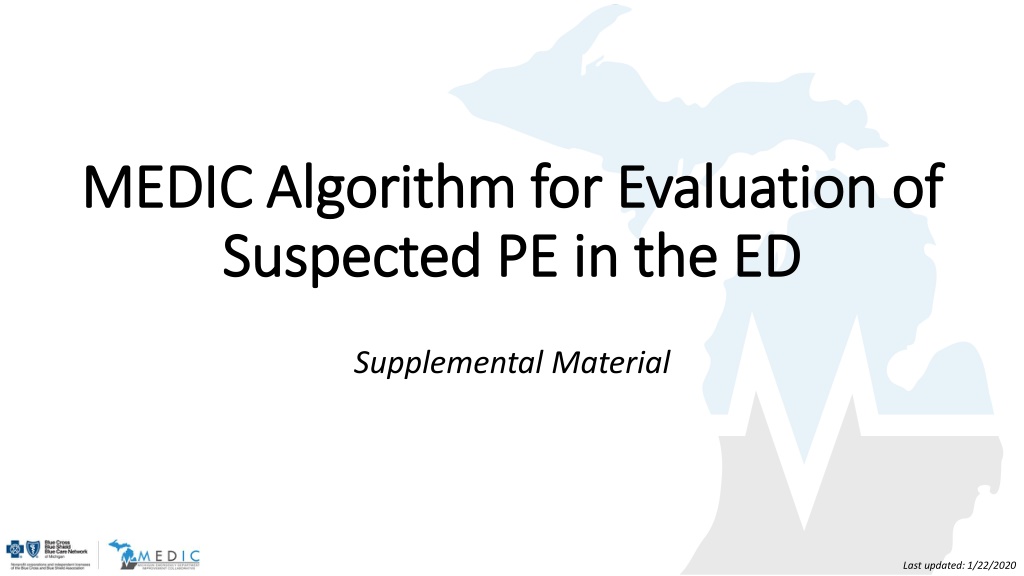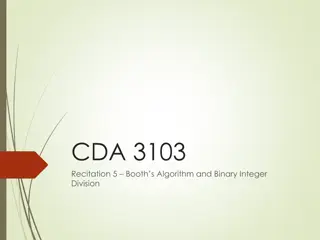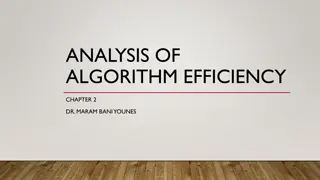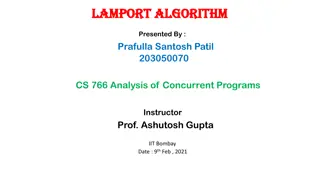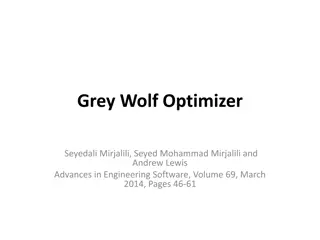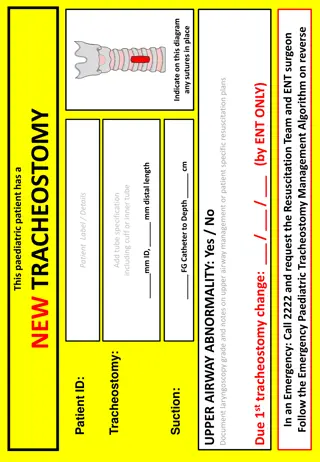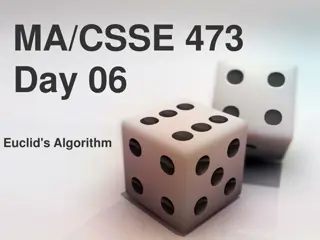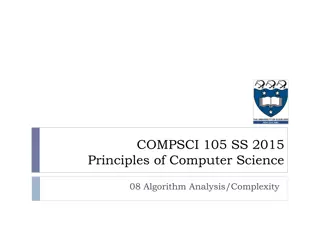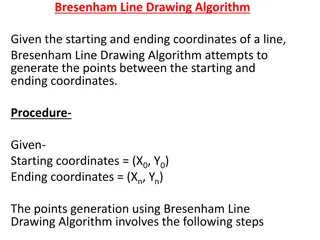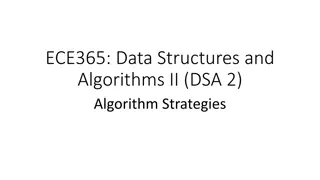MEDIC Algorithm for Suspected PE in the ED
The Michigan Emergency Department Improvement Collaborative (MEDIC) launched in 2015, aiming to standardize the evaluation process for suspected pulmonary embolism (PE) in the emergency department. This consensus-driven algorithm, endorsed by MEDIC, supports ED clinicians in improving the evaluation of PE based on evidence and best practices, addressing concerns such as overuse of chest CT scans, radiation exposure, and tailored testing strategies. It emphasizes a deliberate and calculated approach to evaluating patients with signs, symptoms, or risk factors for PE. This content provides insight into the rationale and goals of utilizing the MEDIC algorithm in ED settings.
Download Presentation

Please find below an Image/Link to download the presentation.
The content on the website is provided AS IS for your information and personal use only. It may not be sold, licensed, or shared on other websites without obtaining consent from the author.If you encounter any issues during the download, it is possible that the publisher has removed the file from their server.
You are allowed to download the files provided on this website for personal or commercial use, subject to the condition that they are used lawfully. All files are the property of their respective owners.
The content on the website is provided AS IS for your information and personal use only. It may not be sold, licensed, or shared on other websites without obtaining consent from the author.
E N D
Presentation Transcript
MEDIC Algorithm for Evaluation of MEDIC Algorithm for Evaluation of Suspected PE in the ED Suspected PE in the ED Supplemental Material Last updated: 1/22/2020
What is MEDIC? The Michigan Emergency Department Improvement Collaborative (MEDIC) was launched in 2015 as an emergency physician-led quality improvement Collaborative comprised of hospitals across Michigan. MEDIC partners with emergency physicians who work together to collect and analyze data, identify best practices based on medical evidence, and improve collective performance. Participating EDs submit data to a clinical registry maintained by the MEDIC Coordinating Center. Support for MEDIC is provided by Blue Cross Blue Shield of Michigan and Blue Care Network within the BCBSM Value Partnerships program.
Why Standardize the ED Evaluation for Suspected PE? Overuse of chest CT for PE in the ED Cost, radiation exposure, overtreatment due to incidental findings Mixed evidence for multiple clinical decision rules No clear single most effective approach to evaluation for PE in the ED Need to tailor testing strategy to pre-test probability of disease Challenging diagnosis with non-specific symptoms Symptoms are regularly encountered in the ED Liability & risk associated with missing clinically significant PE Reasonable and prudent emergency care does not dictate that all patients with a sign or symptom of PE must be tested for PE. Nor does it dictate that a patient with one or more risk factors for PE must undergo testing for PE in the absence of a sign or symptom of PE. 1 1Kline JA, Kabrhel C. Emergency Evaluation for Pulmonary Embolism, Part 2: Diagnostic Approach. The Journal of Emergency Medicine. 2015;49(1):104-117. doi:10.1016/j.jemermed.2014.12.041
What is this algorithm? Consensus-driven Supported by thoughtful review of evidence Developed for ED clinicians by: Practicing ED physicians From multiple health systems Across the state of Michigan To improve ED evaluation of suspected PE Endorsed by MEDIC
Why Pause Pre PE? ED clinicians ONLY apply this algorithm when the available information supports a reasonable concern that the patient may have a PE as a cause of their symptoms. GOALS ED clinicians do NOT apply this algorithm for every patient with signs, symptoms, or risk factors for PE. The decision to initiate an evaluation for PE should be deliberate and calculated. RATIONALE For PE to enter the active differential diagnosis list for any patient, he or she must have at least one possible physiologic manifestation of PE. Kline JA, Kabrhel C. Emergency Evaluation for Pulmonary Embolism, Part 2: Diagnostic Approach. The Journal of Emergency Medicine. 2015;49(1):104-117. doi:10.1016/j.jemermed.2014.12.041 LITERATURE
Why specify clinical gestalt set at <15%? Motivate intentional, systematic pre-test probability assessment, acknowledging the opportunity for decrease in variation of clinical practice. GOALS Clinical gestalt is inherent to assessing cases of suspected PE, even more so due to characteristics such as non-specific symptoms and a lack of a single, clear test for reliable screening for clinically significant PE. RATIONALE A prospective multicenter trial tested the combination of low pre-test probability of PE by clinical gestalt set at <15% in combination with the Pulmonary Embolism Rule-Out Criteria (PERC). The trial was effective at reducing venous thromboembolism risk to below 2% in about 20% of ED patients with suspected PE. Kline JA, Courtney DM, Kabrhel C, et al. Prospective Multicenter Evaluation of the Pulmonary Embolism Rule-Out Criteria. Journal of Thrombosis and Haemostasis. 2008;6:772-780. doi:0.1111/j.1538-7836.2008.02944.x LITERATURE
Why PERC? Confirm no further PE evaluation indicated for patients at low pre-test probability of PE. GOALS Identify patients with low pre-test probability of PE for whom an age-adjusted d-dimer is a warranted evaluation. A systematic review and meta-analysis suggests consistently high sensitivity and low but acceptable specificity of the PERC to rule out PE in patients with low pre-test probability. RATIONALE Singh B, Parsaik AK, Agarwal D, et al. Diagnostic Accuracy of Pulmonary Embolism Rule-Out Criteria: A Systematic Review and Meta-analysis. Annals of Emergency Medicine. 2012;59:517-520. doi:10.1016/j.annemergmed.2011.10.022 LITERATURE
Why <2%? ED clinicians should recognize adverse risks related to testing for PE. GOALS ED clinicians should balance these risks and benefits when initiating testing for PE. ED patients with a pre-test probability of PE below 2% should not undergo d-dimer testing because a positive test result would mandate CT PE. The probability of harm will outweigh the probability of benefit in this patient due to risks from a CT angiogram. RATIONALE Kline JA, Mitchell AM, Kabrhel C, et al. Clinical Criteria to Prevent Unnecessary Diagnostic Testing in Emergency Department Patients with Suspected Pulmonary Embolism. Journal of Thrombosis and Haemostasis. 2004;2:1247- 1255. doi:10.1111/j.1538-7836.2004.00790.x LITERATURE
Why 2-Tier Wells? Confirm imaging indicated for patients likely to have a clinically significant PE. GOALS Identify patients unlikely to have a clinically significant PE for whom a d-dimer is a warranted evaluation. A prospective multicenter cohort study of a simple diagnostic management strategy using a 2-tier Wells score in combination with d-dimer testing and CT was effective in reducing need for CT and risk of venous thromboembolism to <1%. RATIONALE Christopher Study Investigators. Effectiveness of Managing Suspected Pulmonary Embolism Using an Algorithm Combining Clinical Probability, D-Dimer Testing, and Computed Tomography. JAMA. 2006;295(2):172. doi:10.1001/jama.295.2.172 LITERATURE Wells PS, Anderson DR, Rodger M, et al. Derivation of a Simple Clinical Model to Categorize Patients Probability of Pulmonary Embolism: Increasing the Models Utility with the SimpliRED D- dimer. Thrombosis and Haemostasis. 2000;83(03):416-420. doi:10.1055/s-0037-1613830
Why age-adjusted d-dimer? Identify patients unlikely to have a clinically significant PE for whom an age-adjusted d-dimer is warranted evaluation. GOALS A prospective multicenter, multinational study of a diagnostic management strategy inclusive of age-adjusted d-dimer as compared to standard d-dimer interpretation was associated with reduced need for CT testing and no increased risk for venous thromboembolism as compared to standard d-dimer interpretation. RATIONALE A systematic review and meta-analysis found that use of age-adjusted d-dimer substantially increases specificity without modifying sensitivity. Righini M, Van Es J, Den Exter P, et al. Age-Adjusted D-Dimer Cutoff Levels to Rule Out Pulmonary Embolism. JAMA. 2014;311(11):1117. doi:10.1001/jama.2014.2135 LITERATURE Schouten H, Geersing G, Koek H, et al. Diagnostic accuracy of conventional or age adjusted D-dimer cut-off values in older patients with suspected venous thromboembolism: systematic review and meta-analysis. BMJ. 2013;346:f2492. doi:10.1136/bmj.f2492
What is this algorithm? Consensus-driven Supported by thoughtful review of evidence Developed for ED clinicians by: Practicing ED physicians From multiple health systems Across the state of Michigan To improve ED evaluation of suspected PE Endorsed by MEDIC
Key References Christopher Study Investigators. Effectiveness of Managing Suspected Pulmonary Embolism Using an Algorithm Combining Clinical Probability, D-Dimer Testing, and Computed Tomography. JAMA. 2006;295(2):172. doi:10.1001/jama.295.2.172 Kline JA, Courtney DM, Kabrhel C, et al. Prospective Multicenter Evaluation of the Pulmonary Embolism Rule-Out Criteria. Journal of Thrombosis and Haemostasis. 2008;6:772-780. doi:0.1111/j.1538-7836.2008.02944.x Kline JA, Kabrhel C. Emergency Evaluation for Pulmonary Embolism, Part 2: Diagnostic Approach. The Journal of Emergency Medicine. 2015;49(1):104-117. doi:10.1016/j.jemermed.2014.12.041 Kline JA, Mitchell AM, Kabrhel C, et al. Clinical Criteria to Prevent Unnecessary Diagnostic Testing in Emergency Department Patients with Suspected Pulmonary Embolism. Journal of Thrombosis and Haemostasis. 2004;2:1247-1255. doi:10.1111/j.1538-7836.2004.00790.x Righini M, Van Es J, Den Exter P, et al. Age-Adjusted D-Dimer Cutoff Levels to Rule Out Pulmonary Embolism. JAMA. 2014;311(11):1117. doi:10.1001/jama.2014.2135 Schouten H, Geersing G, Koek H, et al. Diagnostic accuracy of conventional or age adjusted D-dimer cut-off values in older patients with suspected venous thromboembolism: systematic review and meta-analysis. BMJ. 2013;346(may03 1). doi:10.1136/bmj.f2492 Singh B, Parsaik AK, Agarwal D, et al. Diagnostic Accuracy of Pulmonary Embolism Rule-Out Criteria: A Systematic Review and Meta- analysis. Annals of Emergency Medicine. 2012;59:517-520. doi:10.1016/j.annemergmed.2011.10.022 Wells PS, Anderson DR, Rodger M, et al. Derivation of a Simple Clinical Model to Categorize Patients Probability of Pulmonary Embolism: Increasing the Models Utility with the SimpliRED D-dimer. Thrombosis and Haemostasis. 2000;83(03):416-420. doi:10.1055/s-0037- 1613830
